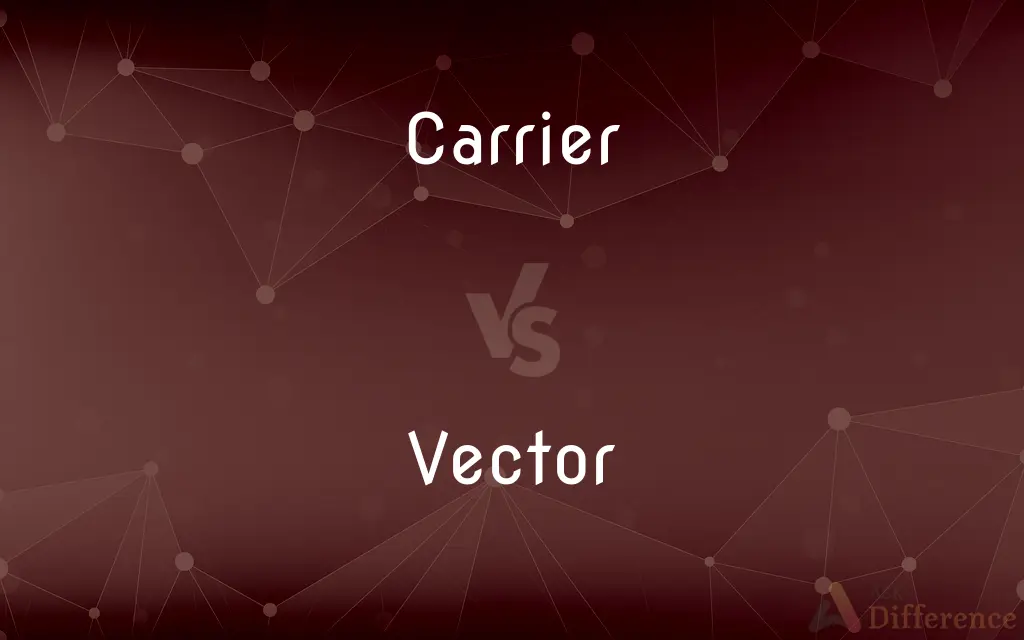Carrier vs. Vector — What's the Difference?
By Tayyaba Rehman & Fiza Rafique — Updated on April 17, 2024
Carriers are organisms that harbor disease-causing pathogens without showing symptoms, potentially spreading diseases; vectors are organisms that transmit pathogens from one host to another, often necessary for the pathogen's lifecycle.

Difference Between Carrier and Vector
Table of Contents
ADVERTISEMENT
Key Differences
A carrier is typically an organism, often a human or animal, that harbors a disease-causing pathogen while remaining asymptomatic. These carriers can spread the disease to others without ever showing signs of the disease themselves. In contrast, a vector is usually an insect or arachnid that transmits infectious pathogens from one host to another, playing a critical role in the life cycle of the pathogen, such as malaria transmitted by mosquitoes.
While carriers do not display symptoms of the disease they carry, they are a reservoir of the pathogen, making disease control challenging as they can unknowingly spread the disease to susceptible individuals. On the other hand, vectors are not just carriers but active participants in the transmission and often the life cycle of pathogens, such as ticks spreading Lyme disease by transferring bacteria when they bite.
Carriers can be continuous, where the organism carries the pathogen for long periods, potentially their entire life, or temporary, during which they carry the pathogen for shorter periods. Vectors, however, are specifically part of the transmission process, often requiring the pathogen to complete a part of its lifecycle within the vector before being contagious or capable of infecting a new host.
The control measures for dealing with carriers and vectors differ significantly. For carriers, public health measures may include identifying and monitoring carrier status individuals and implementing hygiene and quarantine measures. For vectors, control strategies often involve eradication or control of the vector populations, such as using insecticides or managing environments to reduce vector habitats.
Public health implications of carriers and vectors are profound. Carriers can complicate the detection and control of disease outbreaks, as their identification is challenging without symptoms. Vectors, being essential for pathogen transmission, are targeted in public health strategies to interrupt the spread of diseases, especially in areas prone to vector-borne diseases like dengue or Zika virus.
ADVERTISEMENT
Comparison Chart
Definition
Organism that harbors pathogens without symptoms
Organism that transmits pathogens between hosts
Symptoms
Asymptomatic
May or may not show symptoms
Role in Disease
Reservoir of disease
Active participant in pathogen lifecycle
Example Organisms
Humans, animals
Mosquitoes, ticks
Public Health Strategy
Monitoring, hygiene, quarantine
Vector control, habitat management
Compare with Definitions
Carrier
A reservoir host that does not get affected by the pathogen it carries.
Asymptomatic carriers of the virus can complicate efforts to control outbreaks.
Vector
Implicated in many global health issues, particularly in tropical regions.
Vector control is a major public health challenge in combating Zika virus.
Carrier
Often identified through screening in public health contexts.
Carriers of certain genetic diseases are identified through routine newborn screenings.
Vector
An organism, typically an insect, that transmits infectious pathogens between hosts.
Mosquitoes are vectors for malaria, spreading the parasite from person to person.
Carrier
An organism that harbors a pathogen and can spread it without showing symptoms.
She was a carrier of typhoid fever, unknowingly spreading it to others.
Vector
Control strategies include reducing the population or managing habitats.
Draining stagnant water sources reduces mosquito vector populations.
Carrier
Can be a continuous or temporary condition in an organism.
He was a temporary carrier of the virus during its incubation period.
Vector
Often necessary for the pathogen's lifecycle, facilitating its spread.
The tick acts as a vector for Lyme disease by transmitting bacteria during its bite.
Carrier
Key focus in disease prevention and control strategies.
Identifying carriers is crucial in managing diseases like hepatitis.
Vector
Monitoring and research on vectors are crucial for understanding disease patterns.
Vector surveillance helps track the spread of vector-borne diseases regionally.
Carrier
One that transports or conveys
Baggage carriers.
A message carrier.
Vector
A quantity, such as velocity, completely specified by a magnitude and a direction.
Carrier
One, such as a person, business, or organization, that deals in the transport of passengers or goods.
Vector
A one-dimensional array.
Carrier
A mechanism or device by which something is conveyed or conducted.
Vector
An element of a vector space.
Carrier
(Medicine) A person or animal that shows no symptoms of a disease but harbors the infectious agent of that disease and is capable of transmitting it to others.
Vector
An organism, such as a mosquito or tick, that carries disease-causing microorganisms from one host to another.
Carrier
(Genetics) An individual that carries one gene for a particular recessive trait. A carrier does not express the trait but, when mated with another carrier, can produce offspring that do.
Vector
A bacteriophage, plasmid, or other agent that transfers genetic material from one cell to another.
Carrier
(Physics) A boson, especially a gauge boson, that conveys a force or mediates an interaction between subatomic particles.
Vector
A force or influence.
Carrier
A carrier wave.
Vector
A course or direction, as of an airplane.
Carrier
A charge-carrying entity, especially an electron or a hole in a semiconductor.
Vector
To guide (a pilot or aircraft, for example) by means of radio communication according to vectors.
Carrier
An aircraft carrier.
Vector
(mathematics) A directed quantity, one with both magnitude and direction; the signed difference between two points.
Carrier
An insurance or underwriting organization.
Vector
(mathematics) An ordered tuple representing such.
Carrier
A telecommunications company.
Vector
(mathematics) Any member of a (generalized) vector space.
The vectors in are the single-variable polynomials with rational coefficients: one is .
Carrier
A person or object that carries someone or something else.
Armored personnel carrier
Vector
(aviation) A chosen course or direction for motion, as of an aircraft.
Carrier
Ellipsis of aircraft carrier
Vector
(epidemiology) A carrier of a disease-causing agent.
Carrier
A carrier pigeon.
Vector
(sociology) A person or entity that passes along an urban legend or other meme.
Carrier
A person or company in the business of shipping freight.
Vector
(psychology) A recurring psychosocial issue that stimulates growth and development in the personality.
Carrier
A signal such as radio, sound, or light that is modulated to transmit information.
Vector
The way in which the eyes are drawn across the visual text. The trail that a book cover can encourage the eyes to follow from certain objects to others.en
Carrier
(telecommunication) A mobile network operator; wireless carrier.
Vector
A memory address containing the address of a code entry point, usually one which is part of a table and often one that is dereferenced and jumped to during the execution of an interrupt.
Carrier
(aviation) A certified airline.
Vector
(programming) A one-dimensional array.
Carrier
(engineering) That which drives or carries.
Vector
A graphical representation using outlines; vector graphics.
A vector image, vector graphics
Carrier
A piece which communicates to an object in a lathe the motion of the faceplate; a lathe dog.
Vector
(molecular biology) A DNA molecule used to carry genetic information from one organism into another.
Carrier
A spool holder or bobbin holder in a braiding machine.
Vector
To set (particularly an aircraft) on a course toward a selected point.
Carrier
A movable piece in a planetary gear train.
Vector
(computing) To redirect to a vector, or code entry point.
Carrier
(chemistry) A catalyst or other intermediary in a chemical reaction.
Vector
Same as Radius vector.
Carrier
A person or other organism that has a genetic trait, mutation or infection liable to cause a disease, but displays no symptoms.
Vector
A directed quantity, as a straight line, a force, or a velocity. Vectors are said to be equal when their directions are the same and their magnitudes equal. Cf. Scalar.
Carrier
A charge carrier.
Vector
A variable quantity that can be resolved into components
Carrier
A liquid or gas used as a medium for another substance.
Linseed oil used as the carrier for pigment in oil painting
Inert carrier gas, which transports a chemical reactant
Vector
A straight line segment whose length is magnitude and whose orientation in space is direction
Carrier
One who, or that which, carries or conveys; a messenger.
The air which is but . . . a carrier of the sounds.
Vector
Any agent (person or animal or microorganism) that carries and transmits a disease;
Mosquitos are vectors of malaria and yellow fever
Fleas are vectors of the plague
Aphids are transmitters of plant diseases
When medical scientists talk about vectors they are usually talking about insects
Carrier
One who is employed, or makes it his business, to carry goods for others for hire; a porter; a teamster.
The roads are crowded with carriers, laden with rich manufactures.
Carrier
Someone whose employment involves carrying something;
The bonds were transmitted by carrier
Carrier
A self-propelled wheeled vehicle designed specifically to carry something;
Refrigerated carriers have revolutionized the grocery business
Carrier
A large warship that carries planes and has a long flat deck for take-offs and landings
Carrier
An inactive substance that is a vehicle for a radioactive tracer of the same substance and that assists in its recovery after some chemical reaction
Carrier
A person or firm in the business of transporting people or goods or messages
Carrier
A radio wave that can be modulated in order to transmit a signal
Carrier
A man who delivers the mail
Carrier
A boy who delivers newspapers
Carrier
A person who has some pathogen to which he is immune but who can pass it on to others
Carrier
A rack attached to a vehicle; for carrying luggage or skis or the like
Common Curiosities
What are common vector control methods?
Common methods include insecticide application, habitat modification, and biological control strategies.
What defines a carrier in terms of disease transmission?
A carrier harbors and can spread a pathogen without showing symptoms of the disease.
How do vectors transmit diseases?
Vectors typically transmit diseases by biting a host, transferring pathogens into the host's bloodstream.
Why is it challenging to control diseases with carriers involved?
Because carriers do not show symptoms, detecting and isolating them is more difficult, allowing the disease to spread unnoticed.
How effective are vector vaccines in controlling diseases?
Vaccines can be very effective if they target the pathogens carried by vectors, thereby reducing disease incidence.
Are all vectors insects?
Most common vectors are insects like mosquitoes and ticks, but other animals like birds can also act as vectors in spreading diseases.
What strategies are used to educate the public about carriers and vectors?
Public health education campaigns focus on hygiene practices, recognizing symptoms, and taking preventive measures against vectors.
How do public health officials monitor vector populations?
Officials use traps, surveillance, and ecological monitoring to understand and manage vector populations.
Can a carrier become symptomatic later?
Yes, some carriers can eventually develop symptoms, especially if their immune status changes.
What role do asymptomatic carriers play in epidemics?
Asymptomatic carriers can be critical in spreading the disease during an epidemic, as they are not isolated or treated.
Share Your Discovery

Previous Comparison
Sunlight vs. Daylight
Next Comparison
Paliform vs. PalpiformAuthor Spotlight
Written by
Tayyaba RehmanTayyaba Rehman is a distinguished writer, currently serving as a primary contributor to askdifference.com. As a researcher in semantics and etymology, Tayyaba's passion for the complexity of languages and their distinctions has found a perfect home on the platform. Tayyaba delves into the intricacies of language, distinguishing between commonly confused words and phrases, thereby providing clarity for readers worldwide.
Co-written by
Fiza RafiqueFiza Rafique is a skilled content writer at AskDifference.com, where she meticulously refines and enhances written pieces. Drawing from her vast editorial expertise, Fiza ensures clarity, accuracy, and precision in every article. Passionate about language, she continually seeks to elevate the quality of content for readers worldwide.















































